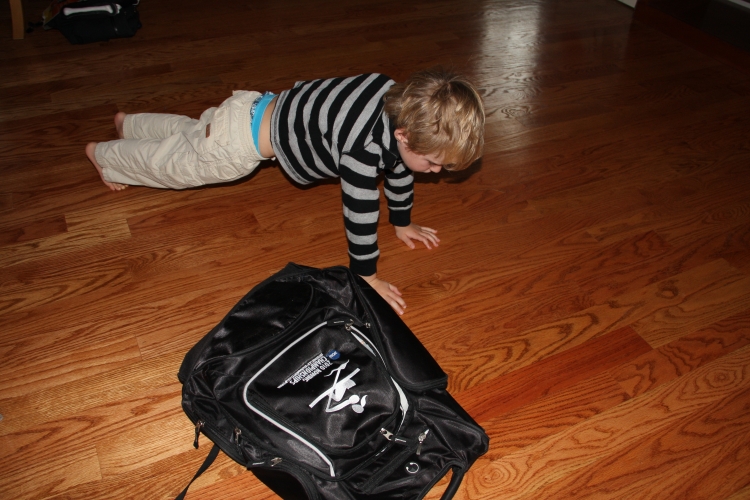row2k Features
Coach Kaehler
Balance your rowing program

Balance your rowing program

Pushups focus on antagonist muscles
Visit Coach Kaehler's site here: CoachKaehler.com.
Do you feel the need to try and balance out your rowing program by cross-training? Most of us want to be better, stronger and healthier rowers. However our commitments to work, family, and other life issues make it hard to find the time to get in additional non-rowing workouts. Simply adding two or three 20-minute strength/core training sessions will add balance to your current program, and lead to better, stronger and healthier rowing. These sessions can be used as a quick warm-up before training, or can be done by as a separate training session.
You can create your own 20-minute balancing program by doing some strengthening exercises that target the opposing (antagonist) muscles to those which are used on the drive of the rowing stroke. We can break up these exercises into the upper body and trunk, and the lower body. While the major muscles (quads, glutes, low back, and rhomboids )used on the drive of the stroke are aggressively working to propel the boat/erg forward, the antagonists are working to provide support and control of the body, and work at a lower level of intensity. The antagonist muscles include the hamstrings, upper and lower abdominals, hip flexors and pectoral muscles to name a few. These antagonist muscles play an important role during the drive of the stroke by maintaining a strong body position. The opposition work the agonists provide creates the platform needed for complete body suspension during the drive.
Adding simple trunk and upper body exercises to your routine, such as push-ups, pull-ups, and sit-ups, is an effective way to start working on your balance. If full body pull-ups are too difficult, use assistance until you build your strength. There are several options for assistance including the use of bands (Ironwoody), using assistive pull-up machines (Gravitron), or by doing lat pull downs. Push-ups can be done on the knees, at full body length, by placing a weight (plate) on your back placed between the shoulder blades, or you can do bench presses. Sit-ups can be done with or without weight placed on the chest, or you can use an incline sit-up bench. When starting out, a good goal is to be able to complete 30 repetitions of each exercise. Then you can increase the intensity level by removing the assistance or adding weight to the movement.
Exercises that balance the lower body should target the opposing muscles and include the hamstrings, lower abs and hips. While many exercises target these muscle groups, starting simply is always a good idea. Some effective exercises include bicycling, scullers, bridges, and leg lifts. These exercises can be done with or without the use of resistance, however you must be able to maintain good control of the low back during the exercise movement before adding any weight to the legs.
When doing bridges or leg lifts, check the starting position of your low back (amount of arch or hallow in your low back) before you start the exercise. A good goal for both these exercises is to maintain the same amount of arch or hollow in the low spine throughout the exercise movement. Control the range of motion of each exercise by monitoring your spine position. Once you have enough strength you will be able to complete a full exercise movement. Limit how far you lower your legs with the leg lifts, and how high you move (extend) your hips off the floor when bridging. As you gain strength in the trunk, your range of motion will increase.
For bicycling and scullers, your low spine will need to curl when doing these exercises. So your goal is to improve endurance and strength. We do this by first increasing volume then increasing intensity (adding weight). Once you can do 30 repetitions with good form, consider adding additional resistance to increase the intensity. A good starting point is completing 30 repetitions without resting before adding resistance to the legs or arms.
Adding just a few 20 minute sessions of balancing exercises to your weekly training program is a simple yet effective way to improve your strength, fitness and overall rowing health.
Do you feel the need to try and balance out your rowing program by cross-training? Most of us want to be better, stronger and healthier rowers. However our commitments to work, family, and other life issues make it hard to find the time to get in additional non-rowing workouts. Simply adding two or three 20-minute strength/core training sessions will add balance to your current program, and lead to better, stronger and healthier rowing. These sessions can be used as a quick warm-up before training, or can be done by as a separate training session.
You can create your own 20-minute balancing program by doing some strengthening exercises that target the opposing (antagonist) muscles to those which are used on the drive of the rowing stroke. We can break up these exercises into the upper body and trunk, and the lower body. While the major muscles (quads, glutes, low back, and rhomboids )used on the drive of the stroke are aggressively working to propel the boat/erg forward, the antagonists are working to provide support and control of the body, and work at a lower level of intensity. The antagonist muscles include the hamstrings, upper and lower abdominals, hip flexors and pectoral muscles to name a few. These antagonist muscles play an important role during the drive of the stroke by maintaining a strong body position. The opposition work the agonists provide creates the platform needed for complete body suspension during the drive.
Adding simple trunk and upper body exercises to your routine, such as push-ups, pull-ups, and sit-ups, is an effective way to start working on your balance. If full body pull-ups are too difficult, use assistance until you build your strength. There are several options for assistance including the use of bands (Ironwoody), using assistive pull-up machines (Gravitron), or by doing lat pull downs. Push-ups can be done on the knees, at full body length, by placing a weight (plate) on your back placed between the shoulder blades, or you can do bench presses. Sit-ups can be done with or without weight placed on the chest, or you can use an incline sit-up bench. When starting out, a good goal is to be able to complete 30 repetitions of each exercise. Then you can increase the intensity level by removing the assistance or adding weight to the movement.
Exercises that balance the lower body should target the opposing muscles and include the hamstrings, lower abs and hips. While many exercises target these muscle groups, starting simply is always a good idea. Some effective exercises include bicycling, scullers, bridges, and leg lifts. These exercises can be done with or without the use of resistance, however you must be able to maintain good control of the low back during the exercise movement before adding any weight to the legs.
When doing bridges or leg lifts, check the starting position of your low back (amount of arch or hallow in your low back) before you start the exercise. A good goal for both these exercises is to maintain the same amount of arch or hollow in the low spine throughout the exercise movement. Control the range of motion of each exercise by monitoring your spine position. Once you have enough strength you will be able to complete a full exercise movement. Limit how far you lower your legs with the leg lifts, and how high you move (extend) your hips off the floor when bridging. As you gain strength in the trunk, your range of motion will increase.
For bicycling and scullers, your low spine will need to curl when doing these exercises. So your goal is to improve endurance and strength. We do this by first increasing volume then increasing intensity (adding weight). Once you can do 30 repetitions with good form, consider adding additional resistance to increase the intensity. A good starting point is completing 30 repetitions without resting before adding resistance to the legs or arms.
Adding just a few 20 minute sessions of balancing exercises to your weekly training program is a simple yet effective way to improve your strength, fitness and overall rowing health.
SUPPORT ROW2K
If you enjoy and rely on row2k, we need your help to be able to keep doing all this. Though row2k sometimes looks like a big, outside-funded operation, it mainly runs on enthusiasm and grit. Help us keep it coming, thank you! Learn more.
If you enjoy and rely on row2k, we need your help to be able to keep doing all this. Though row2k sometimes looks like a big, outside-funded operation, it mainly runs on enthusiasm and grit. Help us keep it coming, thank you! Learn more.
Comments | Log in to comment |
There are no Comments yet
| |
Rowing Features
In the Driver's Seat, with Lizzie Johnston
April 16, 2024
This Week's Best of Rowing on Instagram 4/13/2024
April 13, 2024
In the Driver's Seat, with Athena Santana
April 9, 2024
Wisconsin's Tassneem Arafa
April 3, 2024
US Para Team's Collegians
April 1, 2024
Rowing Headlines
2024 Inaugural CRCA Athletes to Watch
March 13, 2024
World Rowing suspends Serbian Rowing Federation over financial debts
January 23, 2024
National Rowing Hall of Fame ® Class of 2023 Announced
October 5, 2023
Advertiser Index
- Bont Rowing
- Calm Waters Rowing
- Concept 2
- Craftsbury Sculling
- The Crew Classic
- CrewLAB
- Croker
- Durham Boat Co.
- Empacher
- Faster Masters
- Filippi
- Fluidesign
- h2row.net
- HUDSON
- Live2Row Studios
- Nielsen-Kellerman
- Oak Ridge RA
- Peinert Boat Works
- Pocock Racing Shells
- Race1 USA
- RowKraft
- Rubini Jewelers
- Vespoli USA
- WinTech Racing
Get Social with row2k!
Get our Newsletter!
Enter your email address to receive our weekly newsletter.
Support row2k!
Advertiser Index
- Bont Rowing
- Calm Waters Rowing
- Concept 2
- Craftsbury Sculling
- The Crew Classic
- CrewLAB
- Croker
- Durham Boat Co.
- Empacher
- Faster Masters
- Filippi
- Fluidesign
- h2row.net
- HUDSON
- Live2Row Studios
- Nielsen-Kellerman
- Oak Ridge RA
- Peinert Boat Works
- Pocock Racing Shells
- Race1 USA
- RowKraft
- Rubini Jewelers
- Vespoli USA
- WinTech Racing

















